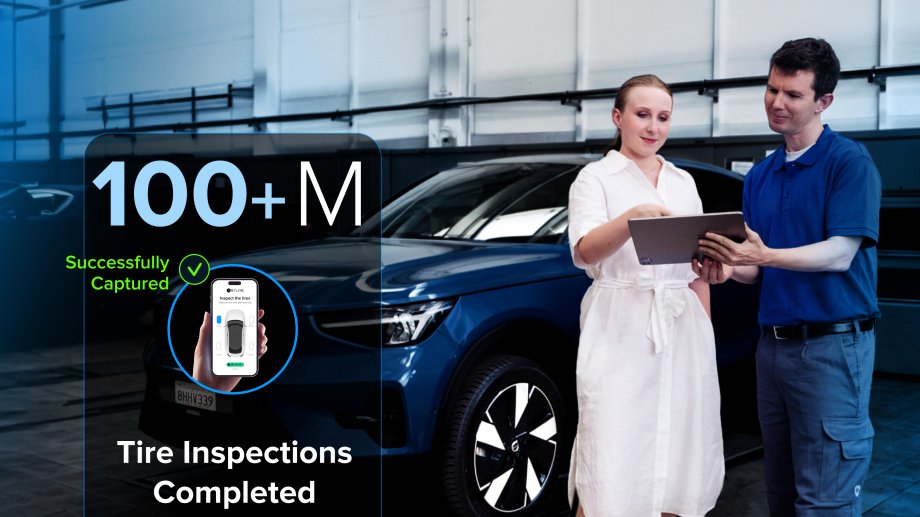
Your tire inspection checklist needs to include tire scanning, and here’s why
Most tire manufacturers recommend that drivers perform monthly checks on their tires for the tire pressure, tread depth, and general wear and tear. But while car owners can verify these basic points themselves, it’s always necessary to visit a repair shop or service center for a more in-depth inspection.
Most often, technicians follow a tire inspection checklist to ensure a full understanding of the tire. Technicians need a DOT tire scanner to capture more data and record it to keep track of inspections and maintenance.
In this blog we will discuss:
- Why should repair shops keep track of tire inspections?
- How does DOT manual recording allow room for failure?
- How does digitization already help?
- How can OCR streamline tire inspection processes?
- How a tire scanner will also boost your sales
- How can repair shops integrate DOT scanning in their tire inspection checklists?
Jump to key topics
Jump to key topics
1. Why should repair shops keep track of tire inspections?
Technicians record various pieces of data when performing a tire inspection. This typically includes the VIN (Vehicle Identification Number), license plate, and the DOT serial number for each tire. Keeping track of this information helps with:
- Identifying the vehicle
- Understanding the history of the tire’s maintenance
- Checking for recalls on those tires
- Knowing the tire’s age for replacement needs
- Planning for future tire maintenance
Recording the DOT ensures accuracy in each individual tire’s condition. If an owner changed the tire themselves, there’s still a way to keep track of this info.
Technicians also need to record observations about the tires including issues that need immediate attention or will soon. This may include the rubber showing signs of aging with small cracks, this may not justify the replacement of the tire.
2. How does DOT manual recording allow room for failure?
Prior to the inspection, technicians need to write down the VIN and DOT. This seems simple, but it’s not efficient for several reasons:
Difficult to Access – Tires installed with the DOT facing inwards require several steps to gather this information:
- Sliding under the vehicle with a flashlight in hand
- Removing each tire
- Using a garage or service station to perform this service
Time Consuming – It takes over 2 and a half minutes to reach and record the DOT from all 4 tires. This can be as long as 5 minutes if they are not facing outward.
Inaccuracies – The Tire Industry Association found a 10 to 15% error rate in DOT recording like this. Human error is a critical factor.
3. How does digitization already help?
Inspections may involve checking the vehicle or tire maintenance history to learn when rotations were completed or any other notes. Pen and paper methods take time and lead to errors. It also requires finding the previous checklists, which is extra, time-consuming work.
Many repair shops now use a better option for this and are moving away from paper to digitized ones. This allows them to access the lists from any mobile device. Technicians can enter notes directly into the digital system. This speeds up access but it doesn’t eliminate the risk of errors being added to the database.
4. How can OCR streamline tire inspections?
The solution is the use of Optical Character Recognition (OCR) technology. It efficiently scans codes, numbers, or series of characters to document the maintenance activities of vehicles.
It can scan the VIN and license plate as well as DOT codes. Technicians simply use a mobile device to scan these to record the information digitally. There are numerous advantages of OCR:
- It’s 5 times faster than typing or writing.
- It’s error-free with no misread codes or typos.
- It works in low light and with upside-down codes.
Using OCR, technicians don’t have to spend time on manual data capture and just focus on the inspection instead.
5. How a tire scanner will also boost your sales
Having data ready and available not only helps you perform better inspections and maintenance, it also boosts your sales and your customer relationship. If most customers only reach out to their tire dealer when they absolutely need to change tires, retailers can foresee when that moment will happen. Most manufacturers and safety agencies recommend changing tires that are 5 years old or more, and that information is available in the DOT code.
By scanning tires during inspections, you record that data and can use it to reach out to customers when their tires approach that age. That way, you can engage with customers before a problem forces them to change tires – and more importantly, before your competitors.
In addition to that, Anyline’s tire scanner also includes a tire size scanning solution. It captures the tire size code from tire sidewalls, and helps you find the right fit in your inventory quickly and easily. It also helps you send targeted offers to your customers, with the right tire for their vehicle, when the time comes to change them.
6. How can repair shops integrate DOT scanning in their tire inspection checklists?
Anyline’s Mobile Data Capture integrates into a technician’s ruggedized mobile device or phone, with no need for additional scanners. It captures DOT, VIN, and license plate information with a simple scan eliminating the need for multiple scanners.
It’s easy to integrate Anyline SDK into existing processes. And, our mobile SDK is natively developed for iOS, Android, and UWP. It supports common integration frameworks including Xamarin, Cordova, React Native, and Flutter. It’s also GDPR-compliant.
This efficient system double-checks each scan. It also can be used offline when the internet goes out. As a complete solution, it meets most needs.

